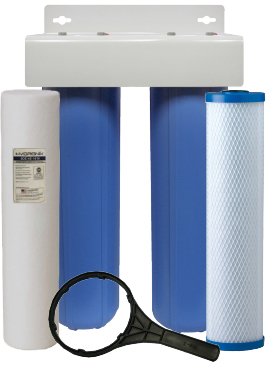Volatile Organic Compounds (VOC s) in Water

Remove Chlorine with a | List Price: US$ Our Price: US$315.95 You save: $203.05 |
What are VOC's
Synthetic organic compounds are chemicals synthesized from carbon and other elements such as hydrogen, nitrogen, or chlorine. They do not occur naturally, but are manufactured to meet hundreds of needs in our daily lives, ranging from moth balls to hair sprays, from solvents to pesticides. VOCs are a class of organic chemicals that have two important properties in common: they evaporate or vaporize readily (they are volatile), and they contain carbon (organic). The manufacture of these chemicals has increased dramatically during the past 40-50 years. It is no surprise that they have found their way into our water supply.
The U.S. Environmental Protection Agency (EPA) estimates that VOCs are present in one-fifth of the nation's water supplies. More than 700 synthetic organic compounds have been identified in various U.S. drinking water supplies. This contamination originates from a variety of sources, including household products and leakage or improper disposal of chemical wastes from commercial and industrial establishments.
Volatile organic compounds have a variety of harmful health effects. At high levels of exposure, many VOCs can cause acute central nervous system depression (drowsiness, stupor). Virtually all VOCs cause skin and respiratory irritation. Long-term exposure to many VOCs is known to cause liver and kidney disorders, severe nervous system problems, and a wide range of cancers. Drinking water containing one or more VOCs at levels above standards should not be consumed. In addition, because little is known about the compound effects of exposure to multiple VOCs, attention should be given if two or more VOC chemicals are found in your drinking water. It goes without saying that all sources of VOC contamination should be eliminated or avoided if at all possible.
How do you remove VOC's from water?
Activated carbon filters are generally very effective at removing most organic contaminants from water; however, certain forms of carbon have a greater capacity for VOC reduction. The following products are recommended for VOC reduction.
Common VOC's found in water
The following is a list of some of the most common volatile organic compounds found in drinking water in North America:
| VOC | Maximum Acceptable Level | Common Sources |
Health Effects |
Most Effective Treatment Technology |
|---|---|---|---|---|
| 2,4,5-TP | 0.05 mg/L | Herbicide on crops, right-of-way, golf courses | Liver and kidney damage | Activated Carbon |
| 2,4-D | 0.07 mg/L | Runoff from herbicide on wheat, corn, rangelands, lawns | Liver and kidney damage | Activated Carbon |
| Alachlor | 0.002 mg/L | Runoff from herbicide on corn, soybeans, other crops | Cancer | Activated Carbon |
| Atrazine | 0.003 mg/L | Runoff from use as a herbicide on corn and non-cropland | Mammary gland tumors | Activated Carbon |
| Carbufuran | 0.04 mg/L | Soil fumigant on corn and cotton | Nervous, reproductive system effects | Activated Carbon |
| Chlorination By-Products | 0.08 mg/L | By-product of chlorination in drinking water | Cancer | Activated Carbon |
| Dibromochloropropane | 0.0002 mg/L | Soil fumigant on soybeans, cotton, pineapple, orchards | Cancer | Activated Carbon |
| Ethylene Dibromide | 0.00005 mg/L | Leaded gasoline additives, leaching of soil fumigant | Cancer | Activated Carbon |
| Heptachlor Epoxide | 0.0002 mg/L | Biodegradation of heptachlor, which is used in insecticides for termites | Cancer | Activated Carbon |
| Lindane | 0.0002 mg/L | Insecticide on cattle, lumber, garden | Liver, kidney, nerve, immune, circulatory | Activated Carbon |
| Methoxychlor | 0.04 mg/L | Insecticide for fruits, vegetables, alfalfa, livestock, pets | Growth, liver, kidney, nerve effects | Activated Carbon |
| o-dichlorobenzene | 0.6 mg/L | Paints, engine cleaning compounds, dyes, chemical wastes | Liver, kidney, blood cell damage | Activated Carbon |
| Styrene | 0.1 mg/L | Plastics, rubber, resin, drug industries, leachate from landfills | Liver and nervous system damage | Activated Carbon |
| Trichloroethylene (TCE) | 0.005 mg/L | Textiles, adhesives and metal degreasers | Cancer | Activated Carbon |
| Xylenes | 10 mg/L | By-product of gasoline refining; paint, inks, detergents | Liver, kidney, nervous system | Activated Carbon |




